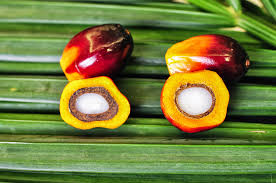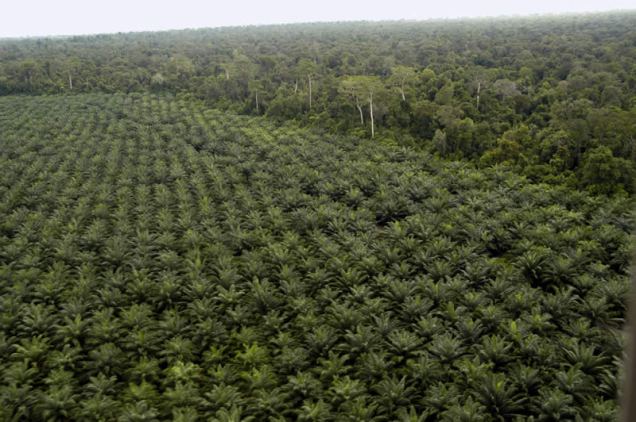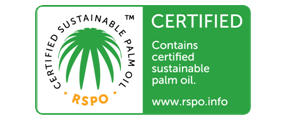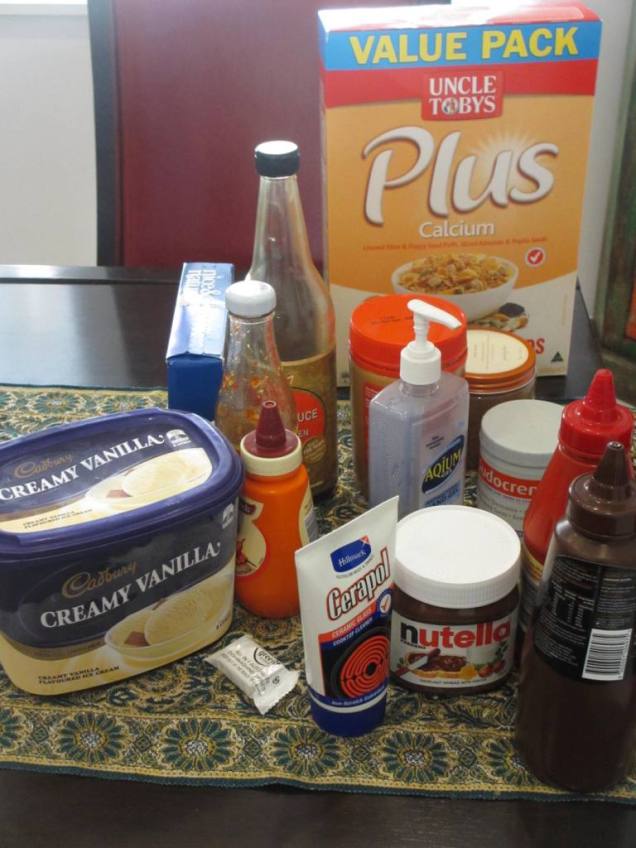Coles is now using sustainable palm oil in all of its Coles brand products.
https://www.coles.com.au/corporate-responsibility/responsible-sourcing-and-sustainability/sustainability/sustainable-palm-oil
orangutan
Palm Oil Detox – an Update
Earlier in Spring, I decided to go on a Palm Oil detox. I set myself a target of reducing palm oil in my house by 50% within 6 months. I’m about half way now and I thought I’d give an update on this journey.
After finding palm oil all too pervasive in many things within my home, I wanted to take action. While I am a lot more aware of the issues related to palm oil, I have to say it hasn’t been easy to detox.
These have been my challenges.
Time: juggling a family, work commitments and home renovations gives me little time. In fact I don’t always do the shopping and leave this to my husband, but the times that I have gone shopping since my detox mission have taken considerably longer. I usually wander through the aisles reading labels and looking up whether something is on the okay list or not according to these sources (http://www.orangutans.com.au/orangutans-survival-information/helping-you-buy-responsibly-palm-oil-free-alternatives.aspx). All in all, I end up a little frustrated and stressed because I usually need to be in and out of a supermarket quick smart.
This issue has gotten a little easier though because we’re starting to know the brands and products that are on the ‘ok’ list which saves us time trawling through websites and wandering aimlessly in supermarket aisles.
Education: As I stated earlier, my husband often does the grocery shopping, so it has taken a few goes to get him to remember to check the palm oil status of a product. The result has been some big purchases which I’m still working through…..
Again, this has gotten better as my husband now knows to check before making purchases and comes and tells me proudly when he has done his research.
Alternatives: If you’ve checked the websites for alternatives to palm oil, you will find that there are not always alternatives. For example, one night I tried to find sustainable palm oil or palm oil free ice cream, but I couldn’t. Or I should say the miniscule and very expensive tubs were not enough to convince me to buy them. Also, I recently had a few guests for an afternoon tea. Without time to bake something myself, it was a mad dash to the shops to buy something. I looked, but apart from bland biscuits there was nothing I could buy! So this got me thinking – the lack of alternatives makes it very difficult sometimes to stick to the plan. I am not a purist and I admire those that are, so I ended up with a few things in my basket which were decidedly not palm oil free. But I also did discover that some products are starting to exhibit their palm free credentials and that makes me happier because at least it’s on the radar of manufacturers as being an issue.
So how am I going really?
I’m doing okay. It was once starting this challenge that I realised how much toiletries I had. Some are quite old and probably not the best to use, but rather than throw things out, I’ve decided to use everything up. This is going quite well and I’m happy in that I am simplifying my life to a degree. I still have a little way to go, but actually there are alternatives that I can readily use, so once I’ve finished the various lotions and potions, I will easily transfer to sustainable palm oil or palm oil free products – yay!
This also extends to cleaning products. Thankfully I was already buying sustainable palm oil products anyway, so a small tweak going forward will have me in a better position.
Now, my main challenge is foodstuffs. I usually eat healthy, so usually buy fresh products, but sometimes I am not so healthy and buy processed foods. The next phase of my detox will be to continue the path I have chosen for where I am doing well, but also to concentrate on food! Here are some general tips from what I’ve found over the last 3 months or so:
• Simplify – simplify your life. Like I said earlier, once I got all my toiletries together, I was quite surprised and I am not a person that buys a lot of toiletries to begin with. Still, I had accumulated a lot and now that I am working through them, I feel so much lighter. I am probably going to buy from now on: Sukin because they are sustainable palm oil products. This is not a paid endorsement, simply my opinion. For more info go to: http://www.sukinorganics.com/sustainability.asp?id=80&pid=3
• Go natural: this is the main tip and one I have to live by more and more. While I use more ‘earth friendly’ cleaning products, I want to reduce these even more and not use many cleaning products. I did an experiment on some grout using bicarbonate soda and I was very impressed with the results. I think the mainstays in my kitchen and bathroom are going to be bicarbonate soda and white vinegar.
As for food, I am going to focus on fresh and homemade. It is one of the surest ways of knowing what’s in something anyway.
As general tips though, what I have found is:
• Opt for chocolate blocks, rather than those with a filling;
• Go for shortbread biscuits rather than filled biscuits;
• Do your research – you may have to make a choice of one things over another. For example, with candles, well that opens another can of worms in relation to soy vs palm oil: http://www.alohabay.com/people/why_no_soy_candles.html
However, I did buy MikeRa candles for my sister as a gift and I especially selected them because of the Sustainable Palm Oil certification.

• Educate those around you. This not only spreads the word, but also helps make sure that gifts that you receive are aligned with your beliefs.
Spring time detox
Spring is in the air in Sydney. The smell of jasmine fills my backyard, flowers are out and after a very wet and cool August, the weather is slowly warming. My daughter is now five and a half months old and getting cuter by the day. She arrived into this world in a house full of madness. My son, then my middle daughter had the chicken pox, so we were confined to my bedroom in quarantine until the house was deemed safe for her to move around in. During this time, I read a lot and to keep me from going crazy my mum borrowed some magazines from the library. One of the magazines that she borrowed was ‘Green Lifestyle Magazine’ (http://www.greenlifestylemag.com.au/). It was while reading this magazine that I learnt about Palm Oil. I already knew a little about Palm Oil, but that article really opened my eyes, but first, some facts about palm oil.
What is palm oil?
Palm oil is a vegetable oil that comes from the tree Elaeis guineensis. The oil comes from the fruit and kernels of the tree. Most palm oil comes from Indonesia and Malaysia (86%).

What is it used for?
Palm oil has many uses. It’s used in anything from toothpaste, soap and shampoo, cosmetics, cleaning products to candles, biscuits, cereals, chocolate and ice cream! Even environmentally friendly, or organic products contain palm oil.
What’s the problem with palm oil?
The main issue with palm oil is that large areas of rainforest are cleared to make way for palm oil plantations. This results in the loss of species and habitats for animals such as the Orangutan.
Additionally, the rainforests that are cleared to make way for palm oil plantations sit on top of peat bogs which are large stores of carbon. As the rainforest is cut and burnt, large amounts of carbon dioxide are released into the atmosphere.

Is all palm oil problematic?
With so many products containing palm oil and its derivatives, it is unrealistic to rid the world of palm oil, so what alternative is there? There is a certification scheme called RSPO (Roundtable on Sustainable Palm Oil) which aims to ensure palm oil used is sustainably sourced. Though this is welcome, we must beware of greenwash and having marketing departments confusing consumers.
Firstly, just because a company is a member of the RSPO it doesn’t mean that they are using sustainable palm oil. Being a member of the RSPO means that they have made a commitment to ‘EVENTUALLY purchase sustainable palm oil, in most cases that commitment is to be in place by 2015’ (http://www.palmoilinvestigations.org/brand-palm-oil-statements).
Usually, if a company is using sustainably sourced palm oil, that they will display this logo and to complicate things further, if a brand states that they use sustainable palm oil, but don’t talk about whether this is certified, then what they may be doing is buying GreenPalm certificates to offset their usage. GreenPalm SUPPORTS the production of sustainable palm oil, BUT the physical palm oil used in the product is not certified.

Now, armed with more knowledge on palm oil, I decided to do some researching to see what I may have, which could potentially have unsustainable (bad) palm oil. When I looked into this website, I was left gobsmacked: http://www.palmoilinvestigations.org/products-australia . What I found particularly interesting, and concerning at the same time is that palm oil is referred to by some many names, which makes it difficult for many to decipher whether products that they buy contain palm oil. Here are just some of the names by which palm oil is known (for a more comprehensive list of names, please see: http://www.palmoilinvestigations.org/Fold%20up%20ingredients%20list-1.pdf):
• Vegetable oil;
• Elaeis guineensis;
• Elaeis oleifera;
• Sodium lauryl;
• Laureth sulphate (can also be derived from coconut oil);
• Cetearyl alcohol;
• Palmate, palmitic acid or Cetyl palmintate;
• Glyeryl stearate; or
• Sodium kernelate.
With my magnifying glass in hand, I set about going through the myriad of everyday products in my home to find whether they contain palm oil and unfortunately I found many. In fact, going through the listing of products from the list in the link above and my fridge, bathroom, kitchen etc, I was overwhelmed.
Here is just a sample of some of the products that I have on my ‘no, does not contain good palm oil’, ‘yes, contains good palm oil’, ‘Don’t know’! This is only a sample though. With limited nap times, I couldn’t go through everything in my home.



So with spring in the air, I’m on a palm oil detox mission! I expect that I will not rid my home of unsustainable palm oil altogether, but I hope in the next 6 months to reduce the unsustainable palm oil present in my home by 50%. I will report on this over the next 6 months and will share any tips and difficulties I face. I look forward to you sharing your journey also.
Resources
Wading through the ‘ins’ and ‘outs’ of this issue is difficult. You almost need a chemistry degree to understand it despite best intentions, however this website is useful and there is an App that should help when out and about shopping: http://www.orangutans.com.au/Orangutans-Survival-Information/Helping-you-buy-responsibly-Palm-oil-free-alternatives.aspx?gclid=CJXu1pX1l8ECFVUAvAod-CAAfQ
Other resources include:
https://www.facebook.com/palmoilproductsinAustralia
http://www.ethical.org.au/know-the-score-in-the-store/
http://www.saynotopalmoil.com/
http://www.zoo.org.au/get-involved/act-for-wildlife/dont-palm-us-off
https://itunes.apple.com/au/app/palm-oil-shopping-guide/id671945416?mt=8
http://www.wwf.org.au/our_work/saving_the_natural_world/forests/palm_oil/


